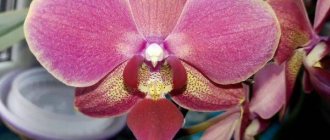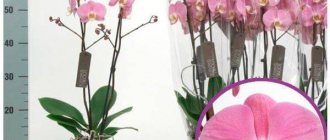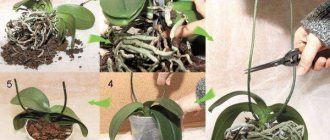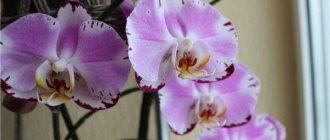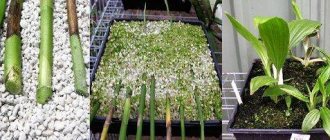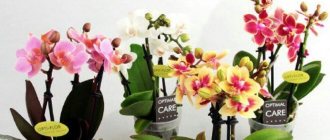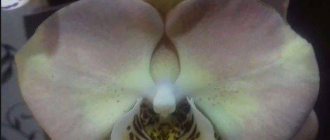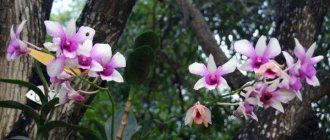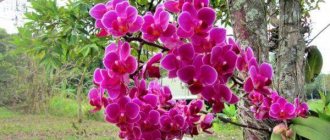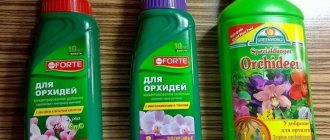Your request has been accepted!
You will receive a notification when the price of the product decreases to the contacts you specified.
Your request has been accepted!
You will receive a notification when the product goes on sale to your contacts.
Branched peduncle, semi-peloric butterfly and peloric butterfly, and flowers of ordinary shape
In the modern flower market you can find almost any type of Phalaenopsis orchid. A variety of colors and sizes will satisfy any, even the most demanding taste .
And with the appearance of many hybrids , this flower became the most popular in home floriculture, winning the competition.
In this article we will consider the following varieties of phalaenopsis: Diamond King, Dendrophalaenopsis and Wild Peach.
Diamond King
Features and external characteristics
Phalaenopsis Diamond King is not a particularly rare variety, but is rarely found in flower shops. Usually having two or three gracefully inclined, straight, peduncles reaching 50 to 70 cm in height in adulthood. Quite a lot of buds are tied on each peduncle.
The leaf is quite large , fleshy, dense. The size of the leaf surface is up to 30 cm in length and 10 cm in width. The number varies from 3 to 5, depending on the care and conditions created.
The flowers resemble bright burgundy butterflies , with a slightly lightened border. Closer to the center of the flower, leopard-print speckles resembling freckles look original.
Story
There is practically no information available in available sources about the origin of this hybrid. All that is known is that he is British . And perhaps, judging by the shape and appearance of the lower sepals, one of the parents was “Phalaenopsis stuartiana”.
Colors
The main color is bright burgundy. Depending on conditions, soil, watering and fertilization, shades may change to light or dark. Often the flowers acquire a cherry color, with creamy tan marks.
The flower border is always lighter than the main color. And above the lip, in the center there are dark yellow spots.
Features, flowering duration and dormant period
It blooms for quite a long time, 3-4 months . Like all orchids of this type, 2 times a year.
Dendrophalaenopsis
It is necessary to understand and know that Dendrophalaenopsis (Dendrobium phalaenopsis) or double-humped dendrobium is a natural species of orchid from the genus Dendrobium. Some gardeners also popularly call it “Dendrophal”.
But this species has its own hybrids. These are the ones we buy.
Motherland
The homeland of this family of orchids and natural habitat is Australia, Singapore and New Guinea.
Features and external characteristics
Externally, Dendrophalaenopsis looks like Dendrobium. It has tall, thick bulbs with numerous growing points. But flowering occurs on peduncles, like phalaenopsis.
This perennial orchid has a sympodial growth habit. It has many thick, fleshy-looking shoots - pseudobulbs, which grow on the rhizome (rhizome).
The plant grows quite quickly . With enough light, new shoots can grow throughout the year.
Peduncles are quite long. They grow from the upper nodes. The number of flowers on each peduncle is impressive Depending on the hybrid, flower sizes range from 4 to 8 cm.
Features, flowering duration and dormant period
The color of the flowers of each hybrid can be completely different - ranging from pure white to very dark purple. The abundance of flowering depends on the amount and duration of daylight hours.
Unlike its species relatives, Dendrophalaenopsis does not have a dormant period during low temperatures. The plant is allowed to rest by reducing or reducing watering. Allow the substrate to dry and only then water it a little. In phalaenopsis this is normal maintenance and proper watering.
On average, flowering lasts about 2 months . But with 5-6 peduncles the bouquet looks amazing.
Why do dendrophalaenopsis leaves turn yellow?
The main conditions for the healthy development of a plant of this type of orchid are a sufficient amount of illumination and support for the plant, close to the seasonal climate changes that occur in its natural environment.
Yellowing of leaves can be due to several reasons:
- Increased room temperature;
- Ineffective use of complex fertilizing (overfeeding);
- Disruption of the root system.
The most common reason that new gardeners encounter is problems in the functioning of the root system due to overwatering or after transplantation.
Kinds
There are a huge number of species of Phalaenopsis orchids. Next, we will give a more detailed description of the most popular varieties of Phalaenopsis orchids.
Phalaenopsis amabilis
Phalaenopsis amabilis - This is the most suitable variety for crossbreeding. It is distinguished by large white flowers. Their size reaches 10 cm. Usually the lip of a flower differs in color. The leaves are fleshy and oblong. They form a rosette of 3-5 sheets. The main part of flowering occurs in late spring. By this time, approximately 20 flowers are developing on the peduncle. They bloom one by one, organizing themselves into flowering phases. They do not have a strong and pronounced aroma.
Phalaenopsis Schiller
Phalaenopsis Schiller. It is famous for the color of its foliage, which, unlike other species, is variegated. The lower part of the leaf is red, while the upper part is a refined mixture of silvery specks on a dark green background. The flowers are about 7 cm in size, but their number is simply amazing. They are collected in inflorescences that grow up to half a meter in length. Approximately 200 flowers are formed on such an inflorescence! Under suitable temperature conditions, this orchid blooms in a cascade, creating a unique beauty. Also during this period, children grow on the orchid. This makes the flower very beautiful and varied. They develop instead of flowers. If a transplant is not carried out, then the decorative component becomes very elegant and unusual.
Orchid pink
Phalaenopsis pink. This is a miniature orchid that surprises not only with its size, but also with the beauty of its flowers. During the flowering period, up to 15 of them grow. Their diameter does not exceed 3 centimeters. They grow on a peduncle, the length of which is up to 20 cm. The lower part of the leaf is red, and the upper part is dark green. The length of the leaves does not exceed 15 centimeters.
Phalaenopsis Sander, Luddeman and Philadelphia
Phalaenopsis Sander. This is the most expensive and rare Phalaenopsis orchid. It is distinguished by variegated foliage and the arrangement of flowers on the peduncle. About 50 flowers from 5 to 7 centimeters in diameter are located on a long peduncle opposite each other. Phalaenopsis sanderiana is a beautiful flower, the beauty of which makes it unique and very valuable.
Phalaenopsis Luddeman. Small orchid. The size of its flower stalks is proportional to the size of the leaves. Their size is approximately 15-25 centimeters. The color of flowers can be varied. From white to pink.
Phalaenopsis Philadelphia. This is a hybrid of two species - Schiller and Stewart. The silvery leaves have a marbled pattern. This hybrid has small purple-pink flowers.
Phalaenopsis giant
Phalaenopsis giant. This is not a hybrid. The giant orchid grows in the tropics and takes root well at home. This is the largest and most beautiful plant of the entire family. It earned its name for the size of its leaves, which reach a length of more than half a meter. Breeders prefer this species because it can be easily crossed with other species and hybrids.
The leaves of the giant Phalaenopsis hang down. Their width can range from 50 centimeters to a meter. The peduncle also hangs down and bears up to 40 flowers, 5-7 centimeters in diameter. It differs from others in the variety of colors of its petals. Shades vary between cream, yellow, yellow-green, and a shaded red-brown pattern. Giant Phalaenopsis also has a pleasant citrus scent.
Wild peach (Phalaenopsis "Wild Peach")
Distinctive features and external characteristics
A distinctive feature of this phalaenopsis is the unusual coloring of the flowers . The shades of flowers largely depend on the conditions of maintenance and care.
Color can vary from orange to pink-orange. The inclusions are brick to burgundy with white dots. The lip of the flower is mostly dark crimson, and the column is bright lilac. See what the Wild Peach orchid looks like in the photo.
Phalaenopsis Wild Peach.
The flowers are quite large . Some plants reach 10.5 cm. The average size ranges from 8 to 9 cm. Peduncles, the number of which can reach 4 pieces, are quite strong and tall.
Story
The history of hybrid phalaenopsis is quite difficult to trace . Hybridization is a fairly long process, starting from natural ones and ending with the hybridization of a number of phalaenopsis with different colors and sizes of flowers, etc.
Surely it could not have happened without Phalaenopsis stuartianum, which became the progenitor of inclusions, spotting and patterns on the petals. Spotted phalaenopsis wild peach, photo below.
Features of flowering, flowering duration and dormant period at home
No peculiarities were noticed in the flowering:
- The duration can also be from 2 to 4 months;
- The rest period cannot be clearly defined by date or season;
- After flowering, the plant needs to grow leaves and root parts;
- Under normal conditions and the necessary temperature changes, phalaenopsis blooms again quite quickly.
And in this video you can look at Wild Peach in more detail:
Video “Types of orchids”
From the video you will learn about the varieties of orchids.
Pleasant (Amabilis) (d12)
This species is attractive with large inflorescences on flexible, slightly curved peduncles. They simultaneously contain up to 20 buds, which open gradually, giving those around them a light aroma and the beauty of the petals.
Large flowers with a diameter of 11 cm are snow-white, yellow and pink. Dark green leaves up to 35 cm in size usually grow in quantities of 6-8 pieces. It is Amabilis that is considered the progenitor of many phalaenopsis hybrids.
Schiller (d12)
This orchid is very similar to Amabilis. It also blooms profusely, but the flowers reach no more than 7 cm in diameter. Up to 200 buds of soft pink and purple color can form on the peduncle at the same time. With proper care, an orchid can bloom for a long period of time, almost without interruption.
This phalaenopsis is unusual for its variegated leaves with green-silver splashes, merging into longitudinal irregular lines. Popular among breeders for its ease of formation of “babies”. Many new hybrid varieties of orchids have been bred from it.
Stuart (d12)
A plant that attracts with its unusual variegation of leaves and silvery roots. The peduncle with branches curved in different directions is rich in the number of buds, which, when opened, reach a diameter of no more than 7 cm. The petals have a snow-white color with reddish spots at the base. In the center of the flower there is a lip of amber-gold color gradually turning into purple.
Sandera
This rare flower is named after the botanist Henry Sander. Its peduncle can reach a length of 80 cm and simultaneously bear from 15 to 50 buds, each 8 cm in diameter. It has from 1 to 6 hard leaves of a dark green color with small light speckles, like a tiger color.
By maintaining a stable temperature during the day 29-32 C and at night - 21-23 C with humidity within 75-80%, the orchid can bloom all year round, the maximum peak of flowering falls in spring and summer.
Lüdemann (d12)
This type of elegant plant is named after the French orchidist Frank Ludemann and has a number of unique features. Its flower has a bright color with intermittent amethyst-purple or chestnut stripes on a white background and a three-stripe small lip with a bright amethyst center. This genus of orchids has petals smaller than sepals, a dense structure with a waxy appearance. This flower with a pleasant aroma can reach a diameter of 3.5 to 6 cm. The leaves are 10-20 cm long and have a bright green color. The peduncle reaches about 20 cm and bears 5-7 small flowers. When grown at home, it requires a humidity of at least 70-80% and maintaining a warm temperature. There are also specifics regarding watering, replanting and fertilizing.
Pink (d12)
One of the varieties of miniature phalaenopsis. It has elongated oval green leaves, reaching 12-14 cm with a red color on the lower part. On a curved purple peduncle, reaching a length of no more than 25 cm, there are usually 15-20 small snow-white-pink flowers with a diameter of 2-4 cm.
The sepals are elongated with snow-white transverse stripes, the lip is three-banded, variegated pink with a brown tint at the base. This microorchid is convenient for keeping indoors.
Giant
Due to the impressive size of the leaves, reaching a length of 90-100 cm, it is considered the largest of the phalaenopsis species. It is especially popular and loved both by amateur flower growers for the beauty of its leaves and flowers, and by breeders for its flexibility in crossing and the possibility of creating new varieties of orchids. The peduncle reaches about 40 cm in length and is capable of producing 30 flowers that exude a sweet citrus aroma.
The flower itself is not so large compared to the leaves, its diameter reaches no more than 7 cm. The color of the petals varies from milky cream to yellow-green with dark brown spots or streaks.
Hybrid
Phalaenopsis hybrid is a large class of hybrids of both natural and artificial selection with a variety of varieties, species and forms. Hybrid phalaenopsis is characterized by long flowering, large flowers of various shapes, colors and shades, and ease of caring for them at home. Today the catalog includes thousands of unique hybrids.
Novelty Phalaenopsis
Orchids, which are characterized by the production of new flower stalks in the presence of old ones. Novelties bloom about 5 times a year. Thus, year-round flowering is achieved due to the unlimited life span of the peduncle. These hybrids typically have small peduncles with only a few open flowers.
The collection of phalaenopsis flowers in miniature is represented by the following species: Peloric, Hummingbird, Equestris (rider), Tetraspis (tetrahedron), Phoenix. Each of them is interesting and surprising with its characteristics and varieties. Phalaenopsis Peloric is unique due to the unusual shape of the flower with a radially symmetrical axis, resulting from genetic mutations. Phalaenopsis hummingbird strikes with a star-shaped flower, similar to a bird. All these flowers are very convenient for keeping in a small apartment, as they take up very little space and are easy to care for.
Of particular interest to specialists is the following collection of orchids:
- Phalaenopsis Legato. The flower can have a golden, pink, lilac color with a pearlescent tint.
- Phalaenopsis Cleopatra is a long-blooming orchid of pearly yellow color with lilac and pink specks.
- Phalaenopsis Midi is one of the medium standard plants of this species.
- Phalaenopsis Singolo is unique in having one flower on a peduncle.
- Phalaenopsis Manhattan has a pink flower color with numerous dark lilac splashes. Attracts attention with its speckled orange lip and beautifully marbled leaves. In translation, Phalaenopsis Manhattan may be accepted as Manhattan.
- Phalaenopsis Limelight is a bright lemon-colored flower with a crimson lip.
- Phalaenopsis Horse/Equestrian has a purple-violet peduncle with small (no more than 3 cm) light pink flowers.
- Phalaenopsis Harlequin is named so due to the brightness of the color of the bud, painted with a variegated palette of white, pink, and crimson.
- Phalaenopsis Kimono - the flower is striking in its petal structure and has a burgundy color.
- Phalaenopsis Hummingbird surprises with its small size and amazing colors.
- Phalaenopsis Bellina in flowering exhibits amazing variations in petal color from white and white-green with a yellowish tint to blue-violet and violet-red. It belongs to the group called “fragrant phalaenopsis”, as it has a pronounced pleasant aroma. Its name Phalaenopsis bellina is often translated as Belina.
- Phalaenopsis Wild Peach is striking in its orange color with darker speckling on the inner part of the petal and yellow coloring on the lower part.
General information on orchids: planting features
Any plant does not like transplantation and reacts negatively with its development for some time. The Dendrophalaenopsis orchid is even more critical of transplants.
It is important to choose a good soil (substrate), consisting of tree bark (preferably pine, but prepared) and other inert components, selected in the correct proportion.
You should also observe:
- The arrival of light
- air circulation,
- Drainage in a flower pot.
Home care rules
Conditions of detention
Caring for modern types of orchids is not very difficult. The main thing is to follow the rules:
- Temperature regime . It is enough to adhere to daytime temperatures of 22-24° C and night temperatures of 15-18° C. Such a difference between temperatures has a beneficial effect on the development and flowering of the orchid;
- Humidity . Air humidity of 40-60% is considered normal. With low or high humidity, growth slows down, flowers begin to dry out, buds fall off, or the color of the foliage changes;
- Lighting. Direct sunlight is strictly prohibited. The plant should be in a well-lit place, but without direct sunlight. Daylight hours should be at least 10 hours.
These conditions are quite easy to establish at home, using in exceptional cases an air humidifier, ventilation or a phytolamp.
Watering and fertilizing
The frequency of watering directly depends on:
The higher the temperature and sufficient lighting, the more often watering is done. The water should be soft and warm (32-34°). It is better to use distilled or rain water.
During the cold season, watering is noticeably reduced.
Proper watering of an orchid.
During the hot period, watering depends on the ability of the root system to absorb and dry the roots. Typically, watering is done once every three days.
Additional nutrition is added during the period of active growth at every third watering. For this purpose, special fertilizers for orchids are used.
Disease Prevention
Basic preventive measures are carried out after purchasing a new pet:
- The substrate changes
- Suspicious areas are treated with fungicidal preparations.
During the growing period, important prevention is compliance with the growing conditions and compliance with the rules of care.
The nuances of transplantation
Any plant has a negative attitude towards transplantation. Acclimatization to new conditions is quite painful and takes a long time.
Therefore, transplantation should be carried out only as a last resort :
- After the purchase,
- If the landing container is cramped,
- For diseases of the root system.
Care
In general, Phalaenopsis varieties differ from each other in foliage color and bud size. This diversity is achieved by crossing different species. Some of the popular varieties combine 3-4 maternal species. This allows you to increase resistance to external irritants. All types of Phalaenopsis are unpretentious in care.
The temperature conditions are quite suitable for placing the flower in the room. Unless in winter you need to be wary of artificial heating, which dries out the air and increases its temperature. Humidity is also quite standard. The main thing is not to reduce it below 50%. The flower is usually placed in light shade or under diffused lighting. This will avoid sunburn and drying out the soil. At the same time, the morning and evening sun does not harm the flower at all.
The watering regime for hybrid varieties of Phalaenopsis orchids is also very convenient even for inexperienced gardeners. You need to water the flower no more than once a week. To understand that it is time to water, you need to touch the soil. If the walls of the container are transparent, then you can see condensation on them. Its presence indicates that it is too early to water.
The soil is also not difficult. It can be purchased in specialized stores, or assembled yourself. Self-collection is a rather complicated procedure. The main thing is that it has good drainage abilities and provides free access of air to the roots.
